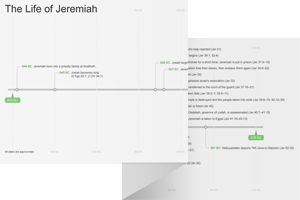52:1–34 The book of Jeremiah concludes with a historical appendix that closely parallels the conclusion of 2 Kings (see 2 Kgs 24:18–25:30). Jeremiah is unique among the Prophetic books because it essentially borrows its ending from another biblical book. The effect is that the book of Jeremiah and the Deuteronomistic History (i.e., Joshua through Kings) have virtually the same ending. This connection suggests that the editors who compiled the historical books might have had a hand in the compilation of Jeremiah’s prophecies. |
52:1 Zedekiah See note on Jer 21:1.
the name of his mother See 2 Kgs 24:18. She is mentioned only in these two passages.
52:2 Jehoiakim See note on Jer 22:18.
52:4 in the ninth year of his reign See note on 39:1. The events described in vv. 4–16 also are recounted in 39:1–10.
Nebuchadnezzar See note on 21:2.
siege works See Ezek 4:2 and note.
52:5 the eleventh year of King Zedekiah The siege lasted about a year and a half, until July of 586 BC. Compare Jer 39:2.
52:7 went out from the city by night Compare 39:4; 2 Kgs 25:4. Also see Ezek 12:4 and note.
the Jordan Valley Refers to the desert area around the Dead Sea. Compare Jer 39:4; see note on 17:6.
52:8 the plains of Jericho See note on 39:5.
52:9 at Riblah in the land of Hamath See note on 39:5.
52:10 he also slaughtered all the officials of Judah See vv. 24–27.
52:11 prison until the day of his death Zedekiah’s imprisonment and death are additional details not found in the 2 Kings account. See 2 Kgs 25:7.
52:12 in the fifth month, on the tenth A month after the city walls were breached (Jer 52:6), the temple and palace were burned down, the city walls were torn down, and all the other large houses of the city were burned.
 Israelite Calendar Table
Israelite Calendar Table
52:16 as vinedressers and farmers See 39:10 and note.
52:17–23 Before the temple was burned, its valuables were plundered, including the large pillars and basins of bronze and all the gold and silver. The list of temple furnishings here is based on the description of the furnishings in 1 Kgs 7:13–39 and is more detailed than the parallel passage in 2 Kgs 25:13–17. |
52:17 the pillars of bronze See 1 Kgs 7:15.
the kettle stands See 1 Kgs 7:27.
the sea of bronze See 1 Kgs 7:23.
52:20 the twelve bronze oxen See 1 Kgs 7:25.
52:21 one pillar was eighteen cubits See 1 Kgs 7:15.
52:24 Zephaniah See note on Jer 21:1.
three keepers of the threshold See note on 35:4.
52:28–30 One of the main differences between Jeremiah’s account and that of 2 Kgs 25 is this report of three deportations to Babylon. The first correlates with the deportation of Jehoiachin in 597 bc; the second is the deportation from the destruction of Jerusalem in 586 bc; and the third is an otherwise unknown deportation conducted in 582 bc (perhaps connected with the assassination of Gedaliah; see note on Jer 41:1). |
52:31–34 This account is identical to that in 2 Kgs 25:27–30. Nebuchadnezzar’s successor, Evil-merodach (also rendered “Awel-Marduk”), frees Jehoiachin (also called Jeconiah and Coniah) from imprisonment and gives him an honored status as a king in exile. |
52:31 in the thirty-seventh year 560 bc. This date suggests that both the ot historical books and the book of Jeremiah were edited sometime after 560 bc.
Evil-merodach Son and successor of Nebuchadnezzar II. Reigned 562–560 bc.

|
About Faithlife Study BibleFaithlife Study Bible (FSB) is your guide to the ancient world of the Old and New Testaments, with study notes and articles that draw from a wide range of academic research. FSB helps you learn how to think about interpretation methods and issues so that you can gain a deeper understanding of the text. |
| Copyright |
Copyright 2012 Logos Bible Software. |
| Support Info | fsb |
 Loading…
Loading…


